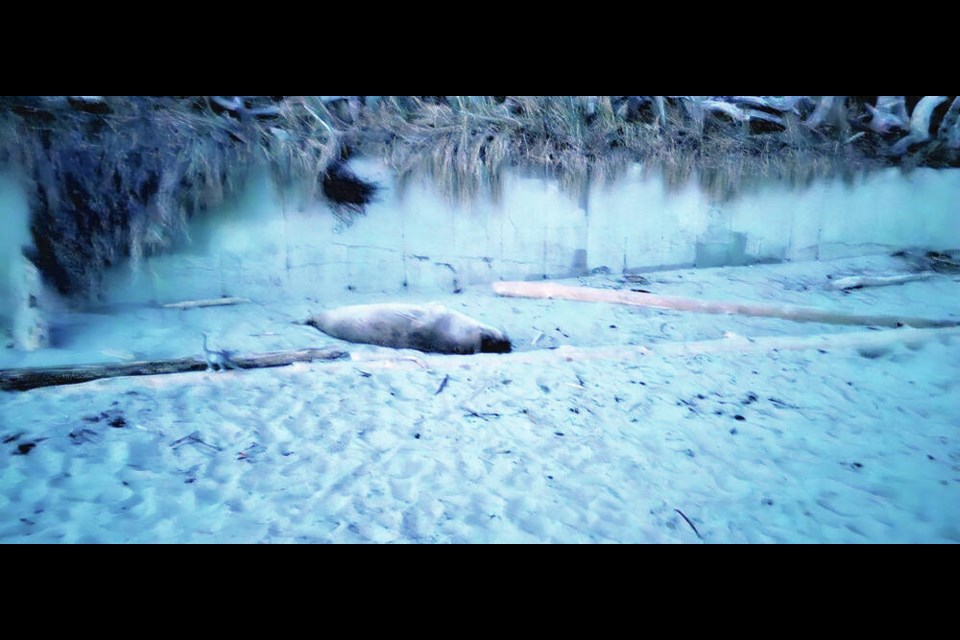The Department of Fisheries and Oceans has confirmed that Victoria’s favourite stair-climbing, beach-lounging elephant seal is back in town, less than a week after he was relocated.
The two-year old juvenile seal known as Emerson was corralled into a van and taken to an undisclosed beach on west Vancouver Island on April 5.
It was the fifth time Emerson had been relocated by DFO since his first appearance at Whiffin Spit in May 2023.
But on Monday, DFO spokesperson Leri Davies confirmed Emerson was once again in Victoria-area waters.
“One amazing critter,” Davies said of Emerson, who is believed to have made the journey from the beach — located in the Barkley Sound area — in just six days.
On Saturday evening, Chris Ashurt took a photo of an elephant seal lazing around on Gonzales Beach.
“Everyone, they just all called it Emerson,” he said. “But that might just be the new collective term for elephant seals at this point.”
Ashurt, who was visiting from Haida Gwaii, had heard about Emerson but wasn’t certain if he had seen the seal in question.
Regardless of the seal’s identity, beachgoers gave it a wide berth. “Everyone was very respectful,” said Ashurt, who posted about his encounter on social media, and said some commentators saw Emerson swimming off the beach on Sunday morning.
Born in January 2022 in Bowman Bay in Puget Sound, Emerson gained a loyal following in Victoria when he spent about a month moulting at Oak Bay Marina Beach last year, and made his way onto the grassy boulevard next to Beach Drive.
Despite several efforts to relocate him, he continues to return to Victoria-area waters.
After he was spotted again this April in the Gorge Waterway in Saanich, then hanging out at Gorge and Admirals roads, he was relocated so he could complete the moulting process in peace, away from humans and off-leash dogs.
Andrew Trites, director of the marine mammal research unit at the University of B.C.’s institute for oceans and fisheries, said he wasn’t surprised to hear that Emerson is back, joking: “Doesn’t everybody like Victoria?”
An earlier research project involving relocating harbour seals from Nanaimo into Barkley Sound proved that seals are able to find their way back to their habitats even when placed in unfamiliar waters, Trites said. “Here, we have another case of that … presumably [Victoria] is an area he’s just comfortable with.”
He said there should be no issue with Emerson spending time in the capital region as long as he keeps to natural habitats and doesn’t stray onto sidewalks or other built environments.
Vehicles are the biggest danger, he said. “If he gets onto a roadway, he can get run over. He’s got no experience with cars.”
Other risks include attacks by dogs and wild animals.
Trites advises against trying to sit on or pet Emerson, saying anyone who tries it could get a “really nasty bite, because he’s not going to allow that type of behaviour.”
Emerson is not habituated to humans in the way that bears or other land mammals might be, as there’s no food involved, Trites said.
“They’re big animals that really have nothing to fear outside of a killer whale,” he said. “They’re just very naive to humans.”
Humans once took advantage of that and hunted elephant seals to the point of near-extinction, he said. “I’m not sure one could teach elephant seals to be afraid of people.”
Elephant seals usually come ashore twice a year, with April and May being prime time for juvenile seals like Emerson to undergo the three-to-five week moulting process, during which they lose their hair and top layer of skin, then regrow their hair to stave off cold in the water.
Trites said Emerson is just doing what’s natural to him. “He’s got to shed his own hair, and when the month is finished, he’ll be back in the ocean and you won’t see him again for another year.”
There is a possibility that the Salish Sea could sustain an elephant seal breeding colony like those commonly found in California and Mexico, he said. “This is the northernmost area where they are being born now.”
In that case, Victorians will have to adapt, he said. “It’s really more about how can people living around the Salish Sea accommodate elephant seals as opposed to thinking — well, we’ll just chuck them off and put them somewhere else.”



